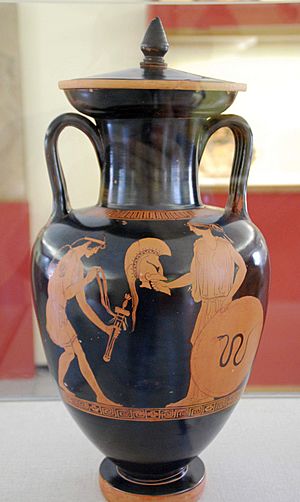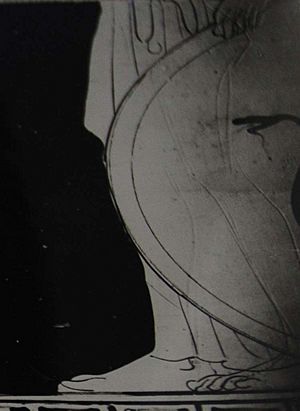Amphora of Hermonax in Würzburg facts for kids
The Amphora of Hermonax in Würzburg is a special type of ancient Greek vase. It's called a neck amphora, which means it has two handles and a narrow neck. This vase was made by a famous early classical Greek artist named Hermonax. He was a vase painter from Attica, a region in Greece. He created this amphora around 450 BC, using a style called red figure painting. This style was very popular in Greek vase painting.
The amphora was discovered in an ancient Etruscan tomb in a place called Vulci. For a while, it was part of the Feoli collection. Today, you can see it at the Martin von Wagner Museum in Würzburg, Germany. It is displayed with a lid, but experts think the lid might not be the original one that came with the vase.
What the Amphora Looks Like
Both the way the vase was made and the pictures painted on it are typical for vases from this time. The main picture on the amphora shows an "arming scene." This means it shows someone getting ready for battle. There are many similar scenes on other vases, but this one is special. A famous art historian, John Beazley, said that Hermonax painted this amphora. Its painting quality is much better than most other vases with this theme.
On the front of the vase, you see a young woman helping a young man get ready. Both of them are wearing a chiton, which is a simple tunic. Usually, a young man would also wear a two-part shirt and skirt for battle. The young man is bending down slightly to put on his sword. Even though it was common to put on leg guards (called greaves) first, here he is putting on his sword. The woman is handing him his helmet. This helmet has parts that can move, like cheek-plates and a face plate. She is also holding his round shield. On the shield, you can see a snake as its special symbol.
Some parts of a soldier's gear are missing from the picture, like body armor, greaves, and a spear. After the Greco-Persian Wars, these items were common for Athenian soldiers called hoplites. Even though the Athenian navy became very important around the time this vase was made, the hoplite soldier was still seen as the perfect citizen and fighter. So, they were often shown in an ideal way for a long time. Also, the long hair on the figures was not fashionable when the vase was made. It was a style from an earlier, heroic time, like during the Persian Wars.
See also
 In Spanish: Ánfora de Hermonacte en Wurzburgo para niños
In Spanish: Ánfora de Hermonacte en Wurzburgo para niños



